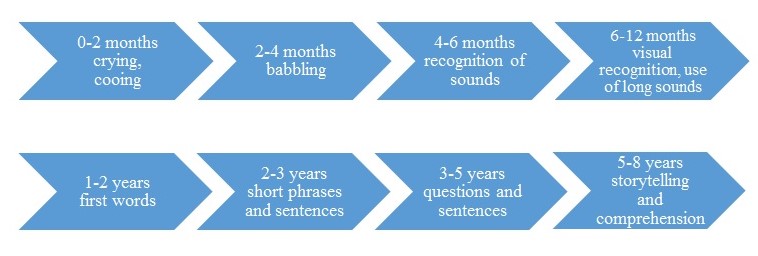
Within the first two months, the infant vocal tract is so small that a child can only express their discomfort via crying, swallowing, sucking, and other physical reactions of the organism (McCauley & Christiansen, 2019). Children make cooing sounds, which is an indication of pleasure. In the second two months, a child learns to babble. A four-to-six month old infant begins to recognize sounds they hear (McCauley & Christiansen, 2019). When parents call the child using their name, they understand that a parent is talking to them.
Starting from month 6, children are able to use long sounds. They can recognize objects by looking at them (McCauley & Christiansen, 2019). At this point, the infant vocal tract resembles the adult one, meaning that their organism is capable of saying words. Children older than one year are expected to produce first words. By the end of twenty four months, they can say as many as ten distinct words, which articulates successful language development (McCauley & Christiansen, 2019). Parents’ role is to provide the basis of words that children will try to imitate.
Age 2 is the milestone during which children start transforming words into short and simple combination of words, which they can use to indicate the desire to have more food, a particular toy, and other inclinations (McCauley & Christiansen, 2019). At age 3, children can make sentences, questions, which become more complex, as the child grows. They can communicate with other children and adults and understand simple concepts. After age 5, a child is ready to learn to read and understand text-based information. By age 8, children can tell long and detailed stories, while understanding that some words have different meanings (McCauley & Christiansen, 2019). At this point, the child is sufficiently prepared to enter a junior school. Parents can use the CDC guidelines as the primary resource to identify inadequacies in the children’s language development.
Whereas sounds are meaningless, speech is the process of word creation, language is the system that allows the transition of meaning. The nativistic theory posits that the ability to communicate is innate and children have to physically develop first to be able to use the language. The behavioristic theory states that children learn languages based on the conduct of the surrounding adults. The interactionist theory is the combination of the other two, stating that both aspects are equally important as long the interaction with other people is present.
Reference
McCauley, S. M., & Christiansen, M. H. (2019). Language learning as language use: A cross-linguistic model of child language development. Psychological Review, 126(1), 1-145.